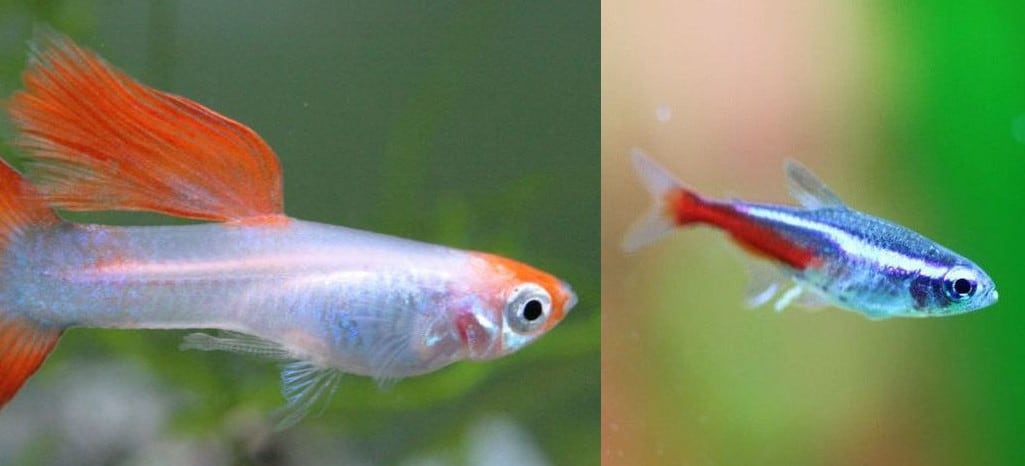Guppies and Tetras – Best Tank Mates?
Aquariums should be a wonderful feature for any home, full of color, vibrancy and stimulation.
One of the best ways of doing this is by introducing lots of smaller, energetic fish species. These can bring a real sense of activity and life to your artificial ecosystem.
Two of the best species to do this are guppies and tetras. Of course, this is no secret. These are two of the most popular aquarium species found all over the world.
In this comprehensive article we will not only explore the peculiar characteristics and personalities of these two aquatic species, but we will also discuss whether they are mutually compatible.
All tank owners will recognize the joy that comes with overseeing a thriving community tank, simply watching the different species interact and the life growing from the bottom up.
We believe that all hobbyists should know that same feeling of unbridled joy, and if you follow the simple tips and tricks given here, then you can achieve this with guppies and tetras.
Table of Contents
What are Guppies?
Video: “Guppy Fish Care, 10 Things You Should Know About Guppies! Great Beginner Fish!”
The simple guppy is one of the most widespread aquarium fish in the world. It is a tropical fish, which means it is used to hotter climates and warmer waters. In fact, it is originally native to the northeast region of South America, though it is now found all over the world. It has also been grown in captivity for many generations, and special adaptations of the species have developed, which are renowned for their vivid color.
You might know the guppy by its alternative name, either the million-fish or the rainbow. Both these common names point to a peculiar trait of the guppy’s character.
Firstly, they are very sociable creatures and therefore they like to roam around in large shoals. In the wild this may also have developed as a defensive strategy to protect them from larger predators. The name ‘rainbow fish’ suggest that they are brightly colored, and this is indeed the case.
A wide variety of vivid colors
Guppies can be found in a wide variety of vivid colors, from deep reds and oranges to bright blues and beguiling greens. This is one of the features that makes it so sought after as an aquarium fish. It is well known that in guppies, as in many other tropical fish, they will display their color most vividly when they feel safe, secure and not distressed. In this way it is a nice qualitative indicator of your fish’s health.
Guppies are a small aquarium fish. Males of the species can grow to a length of about 3 cm, while female guppies may be significantly larger, reaching up to 6 cm long at full maturity. Selective breeding has led to a number of different strains developing, with widely different fin arrangements, as well as coloring and patterns. Most guppies retain some degree of translucency.
Guppies are a resilient little breed, which can survive in a wide variety of ambient environmental and water conditions. There is still some debate about the exact optimum conditions for guppies. However, it is of paramount that they have a good, dedicated diet that fulfills their requirements for crude protein, vitamins and minerals.
What Do Guppies Eat? – Guppy Feeding Guide
Best Food for Guppy Fish – Top 6 Review
What are Tetras?
Video: “MY TOP 5 TETRAS FOR YOUR AQUARIUM”
The tetra is another extremely popular aquarium. Like the ever-popular guppy, it is a small freshwater species which is extremely gregarious and well suited to a lively community tank. In the wild it has a very wide distribution, being found in freshwater bodies in Africa, Central America and South America.
It is a tropical fish, so it too is suited to warm waters. This can support a healthy metabolism. It would struggle in cooler waters, which is something that any prospective owner should consider. Many types of tetra, such as the famous neon tetra, display bright colors and interesting fin arrangements. This can make them a very aesthetically pleasing addition to any tank, which is one of the reasons they are so popular.
Neon tetras possess an iridescent blue stripe that runs along the length of its slender body, but it is mostly transparent apart from this. In fact, the color of their stripe can even change depending on the time of day and their activity level. It may dim slightly at night while the fish rests and reactivate in the morning. Because of their popularity in the hobbyist community, many unrelated species have actually acquired the name Tetra, and it can be quite difficult to differentiate between species.
A great range of shapes and sizes
Tetras can come in a great range of shapes and sizes. However, in general they are small fish which reach about 3.5 cm in size. Because they originally come from warmer, tropical water, tank owners should try and replicate their natural environment as closely as possible. This may involve installing a temperature-controlled heater to keep the temperature of the water between 21 and 27 degrees centigrade.
Recreating the natural environment of the fish means going beyond just getting the temperature right. The responsible tank owner should also try and get a host of other variables right, including the water chemistry, the pH, and even the aquascape and sediment on the bottom of the tank. All this can make your tetra feel more at home and improve their long-term health and well-being.
21 Types of Tetra Fish (With Pictures)
Can Guppies and Tetras live together?

It can be hard to choose between these two attractive species. The big question that a lot of enthusiastic tank owners have is can they keep both species in the same tank. For two species to be comfortable inhabiting the same tank they must fulfill a number of criteria.
First of all, they should have compatible temperaments, meaning they will not attack each other. Also, they need to have similar water requirements, and ideally, they should also have a similar diet to make feeding time less of a hassle. We will explore all these aspects with regards to guppies and tetras.
Temperament
Firstly, both guppies and tetras have the ideal temperaments to live together in a community tank. Both of these aquatic creatures are small, non-threatening fish that will happily go about their own business without causing trouble. They are sociable and peaceful fish, which is exactly what you want. This may arise from their origins in densely populated tropical waters.
One thing you should be aware of is that guppies and tetras should not be placed in a tank with larger, aggressive fish. This could lead to them being distresses, bullied, or even worse, becoming prey. Guppies and tetras will usually thrive in a community setting, whereas on their own they could become lonely and distressed, since it is so unlike their native ecosystem.
Habitat and water conditions
Tetras and guppies also have an overlap in terms of the habitats and water conditions they like. It has already been mentioned that both these species are tropical fish, so they will thrive best in warm waters around 25 C.
They are both freshwater fish, although there is some variance in this regard.
Guppies actually like brackish water best, which is water with a moderate salinity level, between pure freshwater and seawater. Nevertheless, they will live happily in low salinity freshwater as well.
Tetras are mostly found in blackwater streams in the wild, so they are used to slightly acidic water conditions, with the nominal pH ranging from 5-7.
Guppies are also resilient over a range of pH conditions, but neutral water (pH of 7) is probably the best compromise for both species. By maintaining these conditions and keeping the tank clean and clear using a strong mechanical and biological filtration system, you are giving both your guppies and tetras the best chance of leading a long and healthy life.
Diet
Thankfully, guppies and tetras also have similar requirements in terms of diet. Both these species are omnivores. In fact, they have evolved to be opportunistic scavengers who will eat whatever they can find. In the wild this might mean plankton, algae, aquatic vegetation or live prey.
When choosing a fish food, you should choose one which gives them a decent amount of protein (for energy) as well as vitamins and nutrients. You might also want to select a food that helps to accentuate their natural colors. Both species will happily eat live or freeze-dried food such as shrimp or bloodworms, as well as types of vegetables.
[amazon box=”B01GHG1VIU”]
The only problem that keeping guppies and tetras might pose is the problem of them eating the other’s fry. If you are trying to breed either guppies or tetras, then it might be worthwhile to invest in a separate tank or breeding box. This will help to protect the young fry until they are large enough to look after themselves.
Conclusion
It has been conclusively shown in this article that guppies and tetras are ideal tank mates. They both add a real sense of playfulness and variety to an aquarium, especially if you install a large amount of them. Not only that, but their colors are truly mesmerizing, which can transform any fish tank.
They are both sociable fish, which are not territorial or likely to provoke fights. What’s more, they are totally compatible in terms of their preferred water conditions. But species like warm water, of low hardness and neutral pH. Their diet is also so similar that one type of flake or pellet food will be suitable for both types of fish.
If you want an easy, relatively low maintenance way to spice up your fish tank, then introducing guppies and tetras might be the way to go.




